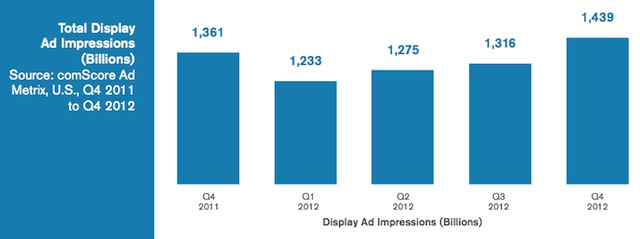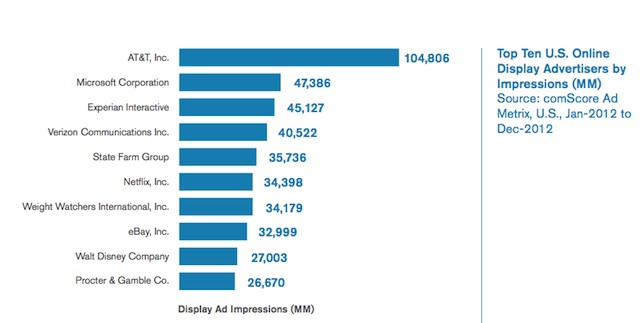comScore just released its Digital Future In Focus report for 2013, offering a broad swath of data in areas like social networking, search and mobile. But the most interesting finding, at least to me, involved display advertising — that 5.3 trillion impressions were served in the United States, but three in 10 are never actually rendered in-view.
That’s consistent with what comScore said in last year’s report when it found that 31 percent of ad impressions are never seen by consumers. Even though this is ongoing issue, the report says we should “look for advertisers to demand more accountability and publishers to reconfigure their site design and ad inventory to improve performance in the coming year.”
More broadly, large advertisers are getting smarter with their ad buys, comScore says, using programmatic buying and improved targeting, so they don’t need to increase their ad buying as much as in the past. For example, there were 144 advertisers delivering more than 1 billion ad impressions in the fourth quarter of 2012 — pretty steady compared to the 145 in the same period of 2011.
Who are these large advertisers? Well, the top advertiser by impressions was AT&T, followed by Microsoft, Experian, Verizon, and State Farm. (AT&T was the biggest advertiser last year too.) The biggest advertiser category was online media, followed by retail and finance.
Taking a closer look at those 5.3 trillion ad impressions, comScore said 1.4 trillion were served in the fourth quarter, a 6 percent increase year-over-year. And one of eight of those ads are “socially enabled,” meaning that they direct viewers to “Like” or “Follow” the advertiser.
As for what’s coming in 2013, the report predicts that publishers are going to resist dropping CPMs (the amount paid per thousand ad impressions) caused by programmatic buying. To fight back, they’re putting their ad inventory in private exchanges, using data to prove ad viewability and engagement, and also doing more to demonstrate that ads drive offline behavior such as in-store sales. And yes, we can expect to see more “native” ads:
Certain large, premium publishers are also beginning to experiment with and implement native advertising based models to deliver unique branded content at scale. Facebook and Twitter have already successfully implemented such ad units that leverage the unique value of their platforms, with the added benefit of being units that work as well on mobile devices as they do on desktop computers. Look for others to follow suit as a means of enhancing the value of their platforms, increasing the value of their inventory and improving the scalability of their content.
There’s lots in the report beyond advertising. For starters, if you’re interested in the overall digital popularity contest, comScore says Google had the most unique US visitors (191.4 million in December), while Facebook was the top in time spent, accounting for a total of 10.8 percent of the minutes spent online.
You can download the full report here.

